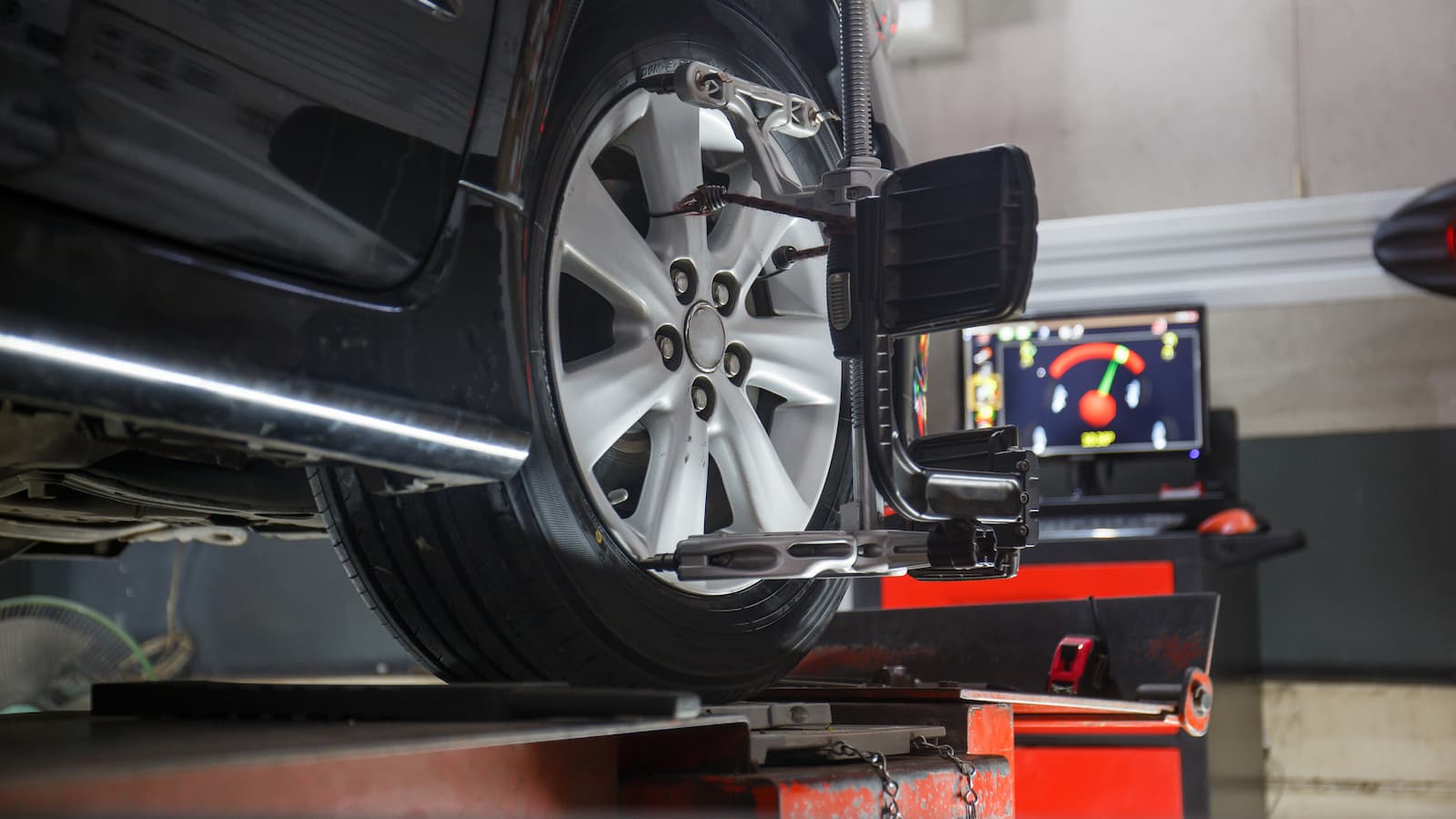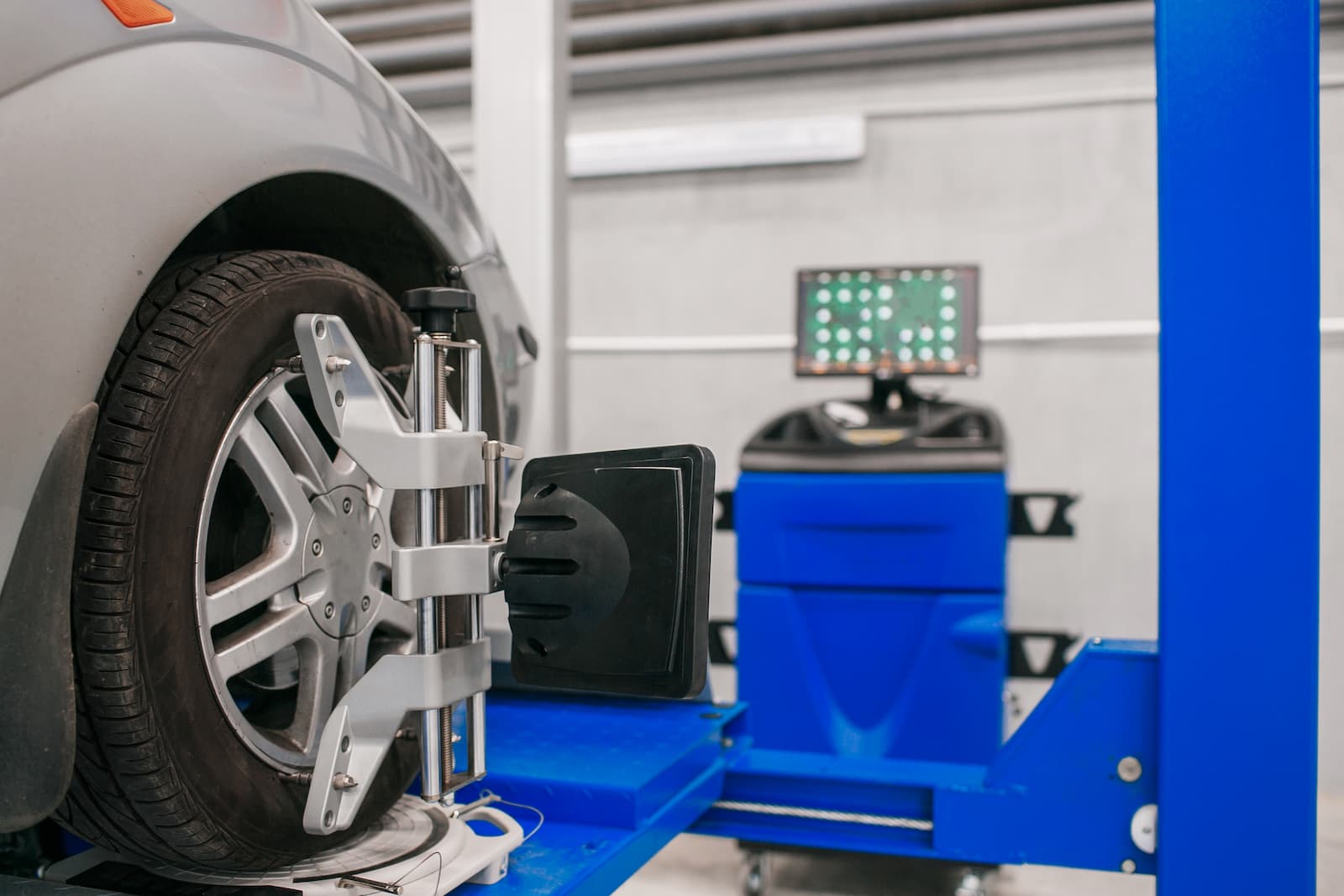Wheel alignment, often overlooked, is an essential aspect of vehicle maintenance critical to optimal vehicle performance and longevity of tires. It involves adjusting the angles of your vehicle’s wheels to the manufacturer’s specifications, ensuring that they are perpendicular to the ground and parallel to each other. This precision alignment is crucial not only for smooth driving but also plays a significant role in reducing tire wear, improving fuel efficiency, and maintaining a stable and controlled driving experience. When your wheels are properly aligned, your car’s handling is at its best, providing a safer driving experience. Misalignment, on the other hand, can lead to uneven tire wear, poor handling, and can even impact the overall health of your vehicle, leading to more significant issues down the road. Regular wheel alignment checks, therefore, are not just about prolonging the life of your tires but are integral to the overall functionality and safety of your vehicle. This blog aims to explore the intricacies of wheel alignment, how it affects your driving experience, and the importance of timely maintenance to ensure your vehicle remains in top condition.
What is Wheel Alignment?
At its core, wheel alignment is a meticulous process that adjusts the angles of the vehicle’s wheels to align with the car manufacturer’s specifications. This critical adjustment includes three primary angles: camber, caster, and toe. Camber, observed from the front, is the tire’s angle relative to the vertical direction – incorrect camber can lead to uneven tire wear and affect handling. Caster, seen from the side, is the steering axis angle, influencing stability and steering effort. Toe, the tire direction relative to the vehicle’s centerline when viewed from above, impacts tire wear significantly. Proper alignment of these angles is essential for ensuring optimal vehicle performance, enhancing tire longevity, and maintaining stability and fuel efficiency. Regular alignment checks are vital to avoid the issues arising from misalignment, such as rapid tire wear and compromised handling, thereby ensuring the vehicle’s safety and efficiency.

Signs Your Vehicle Needs Wheel Alignment
Determining when your vehicle requires a wheel alignment can be straightforward if you know what signs to look for. One of the most apparent indicators is uneven or rapid wear on your tires. This type of wear can manifest as bald spots, or one side of the tire wearing down faster than the other, indicating that the wheels are not aligned properly. Another tell-tale sign is if the steering wheel is off-center during normal driving on a straight road, which suggests an alignment issue. Additionally, if the vehicle tends to pull or drift to one side instead of maintaining a straight path, this is a strong indication that the wheel alignment needs adjustment. Lastly, unusual noises from the tires, such as humming or buzzing, can also signal alignment problems. These symptoms not only point to a compromised wheel alignment but can significantly impact the vehicle’s overall performance and safety. It’s essential to address these signs promptly as prolonged misalignment can lead to further tire damage and potentially hazardous driving conditions, ultimately affecting the handling and stability of the vehicle.
The Impact of Improper Alignment
Improper wheel alignment is a significant concern as it directly impacts vehicle safety, efficiency, and the overall condition of various car components. Misaligned wheels can lead to poor handling and decreased maneuverability, making the vehicle more difficult to control, especially at higher speeds or in emergency situations. This can pose a serious safety risk, as the driver might struggle to maintain the intended path of the vehicle. In terms of efficiency, misaligned wheels increase rolling resistance, which means the engine must work harder to move the car forward, consequently reducing fuel economy. This additional strain on the engine can lead to increased emissions and higher operating costs over time. Furthermore, misalignment causes uneven and accelerated wear on tires, as the uneven distribution of weight and pressure on the tires leads to irregular wear patterns, requiring more frequent replacements. Beyond the tires, misalignment stresses other parts of the vehicle, including brakes and suspension components. This additional wear can lead to premature failure of these components, resulting in potentially expensive repairs and maintenance. Regular wheel alignment checks are crucial to avoid these issues, ensuring the vehicle remains safe, efficient, and reliable on the road.
How Is Wheel Alignment Performed?
Professional technicians use specialized alignment equipment to accurately measure and adjust the wheel angles. This process ensures that your vehicle’s alignment matches the specific requirements set by the manufacturer, optimizing handling and extending tire life.
When to Get Your Wheels Aligned
It’s generally advised to have your wheels aligned every two years or after driving a certain number of miles. Additionally, an alignment check is recommended after events such as hitting a curb, getting into an accident, or installing new tires. Regular checks are an integral part of vehicle maintenance.

Choosing the Right Service for Wheel Alignment
When selecting a service provider for wheel alignment, look for expertise, experience, and a solid reputation. A reputable garage like Cassels Garage will have the necessary equipment and skilled technicians to ensure your vehicle’s alignment is accurately adjusted.
Stay Proactive
Regular wheel alignment is a critical maintenance task that significantly influences your vehicle’s overall performance and safety. By ensuring that your vehicle’s wheels are properly aligned according to manufacturer specifications, wheel alignment enhances the smoothness and stability of handling, providing a more controlled and predictable driving experience. This is particularly noticeable when maneuvering through turns or maintaining a straight path on highways. Additionally, proper alignment plays a substantial role in extending the lifespan of tires. Misaligned wheels lead to uneven tire wear, necessitating premature replacements. Correctly aligned wheels distribute the vehicle’s weight evenly across the tire tread, promoting uniform wear and extending tire life. Beyond tire longevity, wheel alignment contributes to improved fuel efficiency. Misaligned wheels create greater rolling resistance, meaning the engine must exert more effort, thus consuming more fuel. By maintaining optimal alignment, you minimize this resistance, allowing for more efficient fuel usage and reducing overall fuel costs. Proactively scheduling regular alignment checks and adjustments not only safeguards these benefits but also prevents more significant and costly repairs in the future. Neglecting wheel alignment can lead to more severe issues, impacting suspension and steering components. Therefore, investing in routine wheel alignment is a cost-effective strategy to ensure your vehicle remains reliable, safe, and efficient, ultimately saving you money and hassle over your vehicle’s lifespan.





